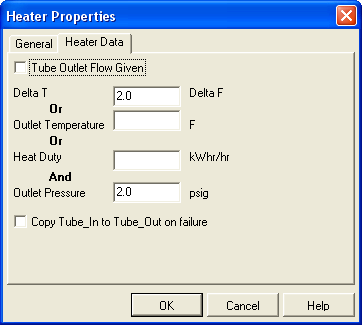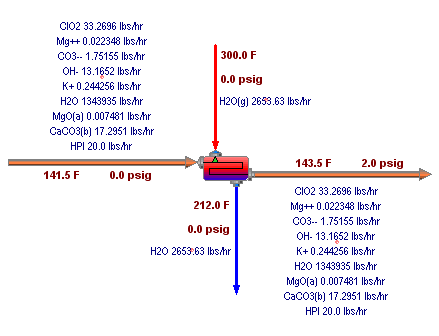What do you want to see?
|
 |
Data Description
| Data | Unit | Description | ||
| Set | Item | Type | Native | |
| Equipment Properties | Tube Outlet Flow Given | If checked (True) the current tube outlet flow is used as the tube side flow. If False the current tube inlet flow is used as the tube side flow. | ||
| Delta T | Temperature Change | Delta F | The temperature change on the tube side. | |
| Outlet Temperature | Temperature | F | The temperature of the Tube_Out stream. | |
| Heat Duty | Energy Flow | BTU/hr | Heat transferred to or from the tube side. The change in energy of the Tube_In stream. | |
| Outlet Pressure | Pressure | psia | The pressure of the Tube_Out stream. Defaults to the Tube_In stream's pressure. | |
| Copy Tube_In to Tube_Out on failure | Temperature | F | Only applies to tube side heating with steam (shell side flow is calculated). | |
Equipment Properties
 |
Example of using equipment
 |
Method&Equations
If the temperature of the Tube_Out stream is set, with no steam involved, the Heater sets the outlet stream temperature and pressure and it determines the enthalpy of the stream.
If the Tube_Out stream temperature is specified and inlet steam stream is connected, the Heater back-calculates the steam flow by first determining the enthalpy of the Tube_Out stream at the new temperature and pressure.
It calculates the steam flow as:
FI2 = ((HO1 - HI1) * FI1) / (HI2 - HO2)
where:
FI2 is the flow rate of steam required and resulting condensate
HO1 is the specific enthalpy of the Tube_Out stream
HI1 is the specific enthalpy of the Tube_In stream
FI1 is the total flow in the Tube_In stream
HI2 is the specific enthalpy of the steam stream
HO2 is the saturated condensate specific enthalpy
If the temperature of the Tube_Out stream is not specified and there is a steam stream connected, the Heater assumes saturated condensate and the enthalpy of the Tube_Out stream is determined as follows:
HO1 = ((FI2 * HI2 - FO2 * HO2 ) + FI1 * HI1) / FO1
where:
FO2 is the flow rate in the condensate stream
FO1 is the flow rate in the Tube_Out stream
 Warnings
Warnings
 Delta T or Outlet Temp or Heat Duty needed!
Delta T or Outlet Temp or Heat Duty needed!
 Shell out colder than cold in!
Shell out colder than cold in!
 Errors
Errors
 Outlet temperature exceeds inlet range!
Outlet temperature exceeds inlet range!

